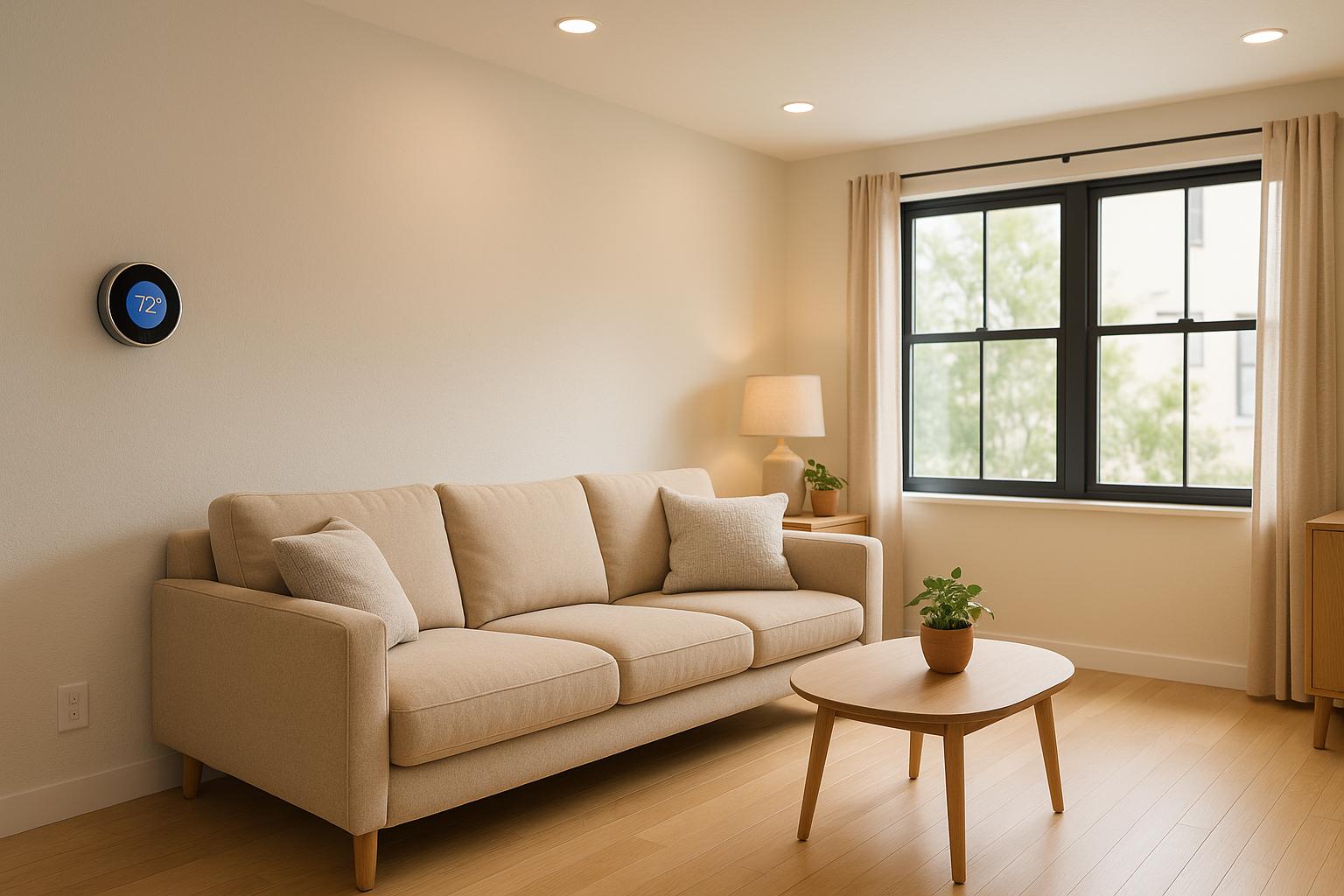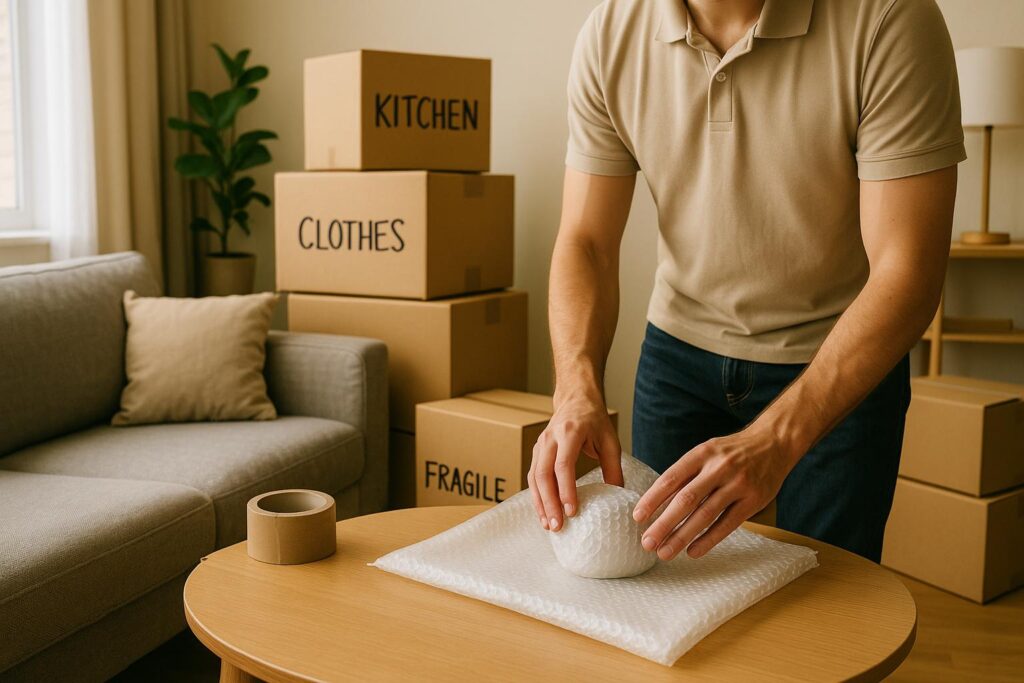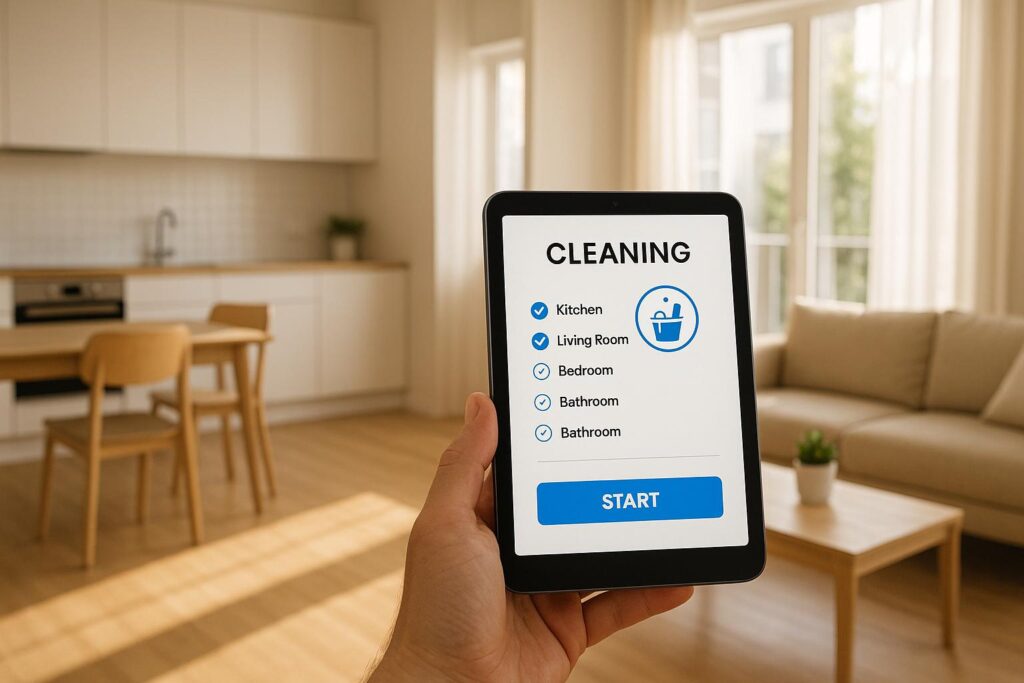Want to cut utility costs for your short-term rental? Here are five practical strategies that can help you save money while keeping your guests comfortable:
- Upgrade to energy-efficient appliances: ENERGY STAR-certified appliances can lower energy use by 10–50%, saving $300–$500 annually. While the upfront cost is higher, the long-term savings make it worthwhile.
- Install smart thermostats: These devices automatically adjust temperatures based on occupancy, reducing heating and cooling costs by 8–26%. Prices start at $79, with potential savings of $50–$250 per year.
- Use low-flow water fixtures: By switching to low-flow faucets and toilets, you can cut water bills by 30%, saving up to $170 annually. Installation is quick and affordable, with many options under $70.
- Set up regular maintenance schedules: Preventive maintenance on HVAC systems and appliances can reduce energy use by 15–20% and avoid costly repairs. Annual costs range from $200–$500, with immediate savings.
- Use smart home technology for utility monitoring: Smart plugs, lighting, and energy monitors can lower electricity usage by 10–30%. Initial costs range from $800–$7,000, with annual savings of $200–$600.
These upgrades not only reduce costs but also appeal to eco-conscious travelers. Start small with smart thermostats and low-flow fixtures for quick results, and consider larger investments like energy-efficient appliances or smart home systems over time.
How To Save Money On Utilities
1. Upgrade to Energy-Efficient Appliances
Switching to ENERGY STAR-certified appliances can significantly lower utility bills. These appliances consume less energy and water compared to standard models, making them an excellent choice for short-term rentals where you’re responsible for utility costs. This simple upgrade also sets the stage for other operational improvements discussed later.
Cost vs. Savings
While the upfront cost of energy-efficient appliances is higher (for example, an ENERGY STAR refrigerator might cost around $100 more), the long-term savings are worth it. These appliances can cut energy use by 10–50%, potentially reducing annual utility bills by $300–$500. If the initial expense feels steep, consider appliance leasing options. Leasing not only lowers upfront costs but also frees up funds for other property upgrades, making it easier to modernize without a large financial commitment.
Why They Work for Short-Term Rentals
Energy-efficient appliances do more than save money – they also enhance the guest experience. For instance, high-efficiency washing machines use up to 40% less water and energy than traditional top-load models, which is especially helpful when guests frequently use laundry facilities. Beyond cost savings, these upgrades appeal to today’s eco-conscious travelers who prioritize sustainable accommodations. By integrating energy-efficient features, you can position your property as environmentally friendly, attract sustainability-focused guests, and stand out in a crowded rental market.
"Energy efficiency isn’t just about saving on utility bills. It’s also about doing our part for the environment and enhancing the quality of life for tenants." – Zoe Harper, Marketing, Steadily
2. Install Smart Thermostats
Smart thermostats bring convenience and efficiency to short-term rentals with features like automated scheduling and remote control. Unlike traditional models, these devices adapt to usage patterns, keeping your property comfortable for guests while cutting down on energy waste during unoccupied periods.
Upfront Cost
Investing in a smart thermostat typically costs between $200 and $450, which includes the device and professional installation. Prices vary depending on the model – budget-friendly options like the Amazon Smart Thermostat are priced at $79, while midrange and premium models, such as the Nest Learning Thermostat ($150–$249) and Ecobee ($170–$240), offer advanced features. Professional installation adds $100–$200 to the total cost, but opting for a DIY setup can help reduce expenses.
Estimated Annual Savings
The upfront cost is balanced by noticeable annual savings. ENERGY STAR certified models can lower heating and cooling expenses by over 8%, translating to yearly savings of $50 to $250. Google Nest users report average savings of 10–12% on heating and 15% on cooling, which equals $131–$145 annually. Ecobee users experience even greater benefits, with savings of up to 26% on HVAC costs compared to traditional thermostats. A study by Resideo found that Honeywell Home T5 and T6 thermostat users in Indiana and Ohio saved between 8% and 16% on heating and cooling costs by actively using scheduling features. These savings not only improve profitability but also streamline property management.
Suitability for Short-Term Rentals
Smart thermostats are particularly well-suited for short-term rentals, where occupancy often fluctuates. They efficiently reduce energy usage during vacancies, making them a practical choice for hosts. Additionally, 72% of renters express interest in smart thermostats, with many willing to pay an extra $25–$75 per month for smart home features.
"I see the most benefit when I’m not home. When I’m home, I don’t always set it at the optimal energy-saving temperature. But if I’m out of the house, it automatically adjusts by 8 degrees or more, and that shows up in the form of directly lowering utility expenses." – Jon Reed, senior CNET reporter and expert in both home energy and AI
For property owners in Austin, smart thermostats can be a game-changer. Reach out to Austin Local Team (https://localteam.ai) for tailored advice and support.
3. Use Low-Flow Water Fixtures
Low-flow water fixtures are a simple yet effective way to reduce water consumption without sacrificing performance. While standard faucets typically use up to 2.2 gallons per minute (GPM), low-flow models reduce this to 1.5 GPM or less. Similarly, low-flush toilets significantly cut water usage, dropping from 3.5 gallons per flush (GPF) to as little as 1.28 GPF. These savings align well with other energy-efficient measures.
Upfront Cost
Cost is always an important consideration. Low-flow fixtures come in a range of prices. For instance, low-flow toilets typically cost between $150 and $500, while low-flow faucets are often priced under $70. If you’re upgrading an entire bathroom or unit, the expense may reach around $1,270. However, many areas offer utility rebates to help offset these costs.
Estimated Annual Savings
Switching to low-flow fixtures can lower water bills by approximately 30%. For example, households that replace older toilets with WaterSense-certified models save over $170 annually. Similarly, upgrading to low-flow faucets can conserve around 700 gallons of water a year, translating to savings of about $90 at current rates.
Ease of Installation
Installing low-flow fixtures is often quick and straightforward. Many attachments, such as low-flow showerheads, can be installed in less than five minutes using basic tools. For more complex upgrades, like replacing toilets or multiple fixtures, it’s a good idea to consult a local plumber.
Suitability for Short-Term Rentals
Low-flow fixtures are an excellent fit for short-term rental properties. They help manage unpredictable water usage while ensuring guest comfort. Plus, these upgrades appeal to eco-conscious and budget-minded renters, making your property stand out.
"Low-flow fixtures cut water use and lower utility bills without hurting performance. By using low-flush toilets, faucet aerators, and efficient washing machines, homeowners can save a lot of money over time and help the environment." – ServiceTitan: Scheduling Pro
For more property improvement tips, visit Austin Local Team at https://localteam.ai.
sbb-itb-4c99469
4. Set Up Regular Maintenance Schedules
Keeping up with regular maintenance is a game-changer for cutting utility costs in short-term rentals. While it might feel like an extra expense, preventive maintenance can slash HVAC breakdowns by up to 95% and trim energy usage by 15% to 20%. By addressing small issues before they escalate, you ensure your systems run efficiently and avoid costly emergencies.
Building on energy-efficient upgrades and smart thermostat installations, consistent maintenance ensures these technologies continue to work at their best. Focus on the property’s biggest energy users for the most impact. For instance, HVAC systems need monthly filter replacements, bi-annual coil cleaning, and routine checks for worn-out parts. Adjusting your water heater to 120°F alone can save about $120 a year. Regularly inspecting for leaks can also prevent significant water loss.
Other tasks include cleaning refrigerator coils twice a year to maintain energy efficiency and clearing the dryer vent after every guest stay. Sealing gaps around windows and doors with caulk helps eliminate drafts, reducing the strain on your HVAC system.
Upfront Cost
Setting up a maintenance schedule doesn’t require a huge initial outlay. Bi-annual HVAC tune-ups typically cost $99–$129 per unit, and a full preventive maintenance plan can run as low as $200 annually. Specific services like appliance check-ups cost between $100 and $200, while HVAC servicing ranges from $150 to $200. Compare this to emergency repairs, which can set you back anywhere from $500 to $3,000 for HVAC failures.
Estimated Annual Savings
The savings from regular maintenance are impressive. Planned maintenance can reduce HVAC system costs by 25-30%. Fixing common household leaks can save an average of 10,000 gallons of water per year, and something as simple as repairing a dripping faucet can save up to 3,000 gallons annually. Over time, these small fixes add up, significantly lowering your utility bills.
Suitability for Short-Term Rentals
Just like energy-efficient appliances and smart thermostats, regular maintenance is particularly important for short-term rentals, where high guest turnover accelerates wear and tear. Preventive care ensures systems perform reliably, even under frequent use. For example, consistent HVAC maintenance can extend the system’s lifespan from 10 years to 15–20 years, which is crucial for properties generating year-round income.
"Water is such a precious resource and should never be wasted. Managing it effectively for your short-term rental is not difficult and can save you money and help build sustainability into your operations. Taking action will please your guests, help your bottom line and do the right thing by the planet." – Bob Garner, Founder of EnviroRental
To keep everything running smoothly, establish a clear schedule: monthly filter changes, quarterly inspections, and annual deep cleanings. Encourage guests to report any issues promptly – quick fixes prevent costly damage and help keep utility bills predictable. Regular maintenance ties all your energy-saving strategies together, ensuring long-term efficiency and savings.
5. Use Smart Home Technology for Utility Monitoring
Smart technology offers a modern way to track and manage energy use in real time. Instead of focusing on individual elements, these systems provide a clear, overall picture of how energy is consumed across your rental property. This approach works hand-in-hand with any energy-efficient upgrades you’ve already put in place.
Smart home energy monitoring systems connect to your electrical panel, keeping tabs on electricity usage down to individual circuits. This means you can identify which appliances or areas of the property are consuming the most power. Tools like smart plugs, power strips, and lighting systems help reduce electricity usage, especially the "phantom" or standby power that devices consume even when not in use. For instance, smart lighting can slash electricity usage by up to 75% compared to traditional bulbs. A key insight? "Always On power accounts for 23% of the average electric bill, which makes it an opportunity for big savings".
Upfront Cost
The cost of setting up smart home utility monitoring depends on the level of automation you’re aiming for. Wireless systems are great for smaller properties, with prices starting in the hundreds of dollars. For basic setups, like a smart thermostat, packages can start at around $800.
Here’s a breakdown of device costs and installation:
| Device Type | Price Range | Professional Installation |
|---|---|---|
| Smart thermostats | $70 – $280 | $80 – $100 per hour |
| Smart plugs (per plug) | $10 – $30 | DIY friendly |
| Smart lighting (per light) | $20 – $50 | $15 – $150 for switches |
| Smart power strips | $20 – $50 | DIY friendly |
| Complete lighting system | $1,000 – $3,000 | Included |
Professional installation typically runs $80 to $100 per hour, with wireless setups taking just a few hours (costing about $150 to $200 in total). For more advanced systems that automate the entire home, expenses can range from $2,000 to $7,000.
Estimated Annual Savings
Smart monitoring systems can deliver noticeable savings. Homeowners who use these technologies often report cutting their monthly energy costs by 10–30%. For example, smart plugs and outlets alone can save $100–$200 annually by reducing phantom energy drain. Studies show that homes with energy monitors can lower electricity use by up to 15%, with an average reduction of about 7%. Smart lighting systems, in particular, have shown energy savings of up to 90%.
"The amount an average user can save with a home energy monitor like Sense varies depending on several factors, such as the size of the home, the number of devices being used, the efficiency of appliances, and the user’s current energy habits." – Sense Energy Spokesperson
Ease of Installation
Smart home devices are becoming more accessible, especially for short-term rental properties. By 2021, over 35% of property managers were already using IoT solutions for tasks like entry management. In cities such as Miami, Las Vegas, and San Diego, installations of smart locks in short-term rentals jumped by 60% by 2023. Many devices feature plug-and-play setups, making installation straightforward. While wireless systems are easy to install on your own, more complex hardwired systems may need a professional electrician.
Suitability for Short-Term Rentals
Smart monitoring technology is a great fit for short-term rentals, addressing the challenges of remote management and frequent guest turnover. These devices simplify property management from afar, allowing real-time solutions to any issues that arise. When paired with other energy-saving measures, they ensure consistent performance between guest stays. Additionally, many property management software platforms now integrate seamlessly with these devices, enhancing the overall guest experience.
"Overall, the reasons to install an energy monitor can go far beyond behavior change, though it can certainly help with that. It gives insight into your home in a way that isn’t available any other way." – Joel Rosenberg, Senior Program Manager for Special Projects at Rewiring America
To get the most out of these systems, consider adding simple how-to guides or FAQs about the devices in your guest guidebook. Training cleaning staff on how to use the technology and testing everything before guests arrive can also help ensure a smooth experience. By combining smart monitoring with thoughtful preparation, you can keep utility costs in check across all bookings.
Cost and Savings Comparison
To help you decide which upgrades offer the most value, here’s a breakdown of costs, savings, and installation challenges for various utility-saving methods. This table provides a clear look at which upgrades deliver the best returns:
| Method | Upfront Cost Range | Annual Savings | Payback Period | Installation Difficulty |
|---|---|---|---|---|
| Energy-Efficient Appliances | $500 – $3,000 per appliance | $100 – $400 | 2–4 years | Moderate (professional recommended) |
| Smart Thermostats | $100 – $350 | $140 – $250 | 6 months–1.5 years | Easy to Moderate |
| Low-Flow Water Fixtures | $50 – $300 per fixture | $80 – $200 | 1–2 years | Easy (DIY friendly) |
| Regular Maintenance | $200 – $500 annually | $150 – $400 | Immediate | Easy (scheduled service) |
| Smart Home Monitoring | $800 – $7,000 | $200 – $600 | 1.5–3 years | Easy to Complex |
Smart thermostats stand out for their quick return on investment (ROI). With prices starting as low as $100 and annual savings between $140 and $250, they can pay for themselves in as little as six months. Considering that heating and cooling can make up as much as 55% of a home’s energy use, these devices can have a big impact on energy bills.
Energy-efficient appliances, while requiring a larger upfront cost, offer substantial long-term savings by reducing energy consumption. They’re ideal for properties with older, less efficient appliances.
Low-flow water fixtures are an excellent choice for those looking for an affordable, easy-to-install upgrade. These fixtures provide immediate savings on water bills without requiring significant installation costs or expertise.
Regular maintenance is often overlooked but can deliver immediate savings by ensuring equipment operates efficiently. Preventing emergency repairs and extending the life of appliances makes this a cost-effective strategy, especially when paired with other upgrades.
Smart home systems, though more expensive and complex, can cut energy use by 10–30%. These systems are particularly beneficial for larger properties or landlords managing multiple rentals, where the savings scale with property size.
Savings can also vary depending on local factors. For instance, Ecobee notes that climate, personal comfort preferences, occupancy patterns, and HVAC system specifics all influence energy savings. Homes in extreme climates often benefit most from smart thermostats, while older properties may see bigger gains from appliance upgrades and consistent maintenance.
For short-term rental owners, starting with smart thermostats and low-flow fixtures is a smart move for quick savings. These upgrades are cost-effective and easy to implement, while larger investments like appliances or smart home systems can be planned for the future. By weighing these options carefully, you can make strategic choices that not only save money but also enhance guest experiences.
Conclusion
The strategies outlined above can work together to cut down costs and increase property value. By implementing these five approaches, you can transform utility expenses into opportunities for profit.
The benefits of energy savings are undeniable. For instance, ENERGY STAR appliances can reduce energy consumption by up to 15%, while LED lighting uses 75% less energy compared to traditional options. These upgrades not only lower operating costs but also appeal to eco-conscious travelers who prioritize sustainable accommodations. Properties featuring these amenities often enjoy better reviews, increased bookings, and even justify higher rental rates.
On top of that, rebates and tax incentives can help offset the initial costs of these upgrades. When combined with the energy-saving tips shared earlier, these measures create a pathway to managing properties more sustainably and profitably.
If you’re a property owner in the Austin area, collaborating with local experts can amplify these benefits. Austin Local Team provides tailored advice specific to the Austin market, connecting you with reliable contractors familiar with local regulations and incentive programs. Their deep understanding of Austin’s real estate trends ensures that your investments in utility efficiency yield the best possible returns in this competitive landscape.
Start small with upgrades like smart thermostats and low-flow fixtures, then consider larger projects such as appliance replacements or full smart home systems. Not only will these changes enhance your guests’ experience with added comfort and sustainability, but they’ll also lower your operating costs and boost your property’s value.
FAQs
How can smart thermostats help reduce utility costs in short-term rental properties?
Smart thermostats have transformed the way short-term rental properties manage heating and cooling. These devices are designed to adjust temperatures automatically, aligning with guest habits to maintain comfort while reducing energy use. For example, they can scale back energy consumption when the property is unoccupied or fine-tune settings depending on the time of day.
Another major perk is the ability for property owners to monitor and control temperatures remotely. This ensures that the system isn’t running unnecessarily between guest stays, helping to cut down on utility costs – a big advantage for vacation rentals or properties with high guest turnover.
What challenges should I consider when adding smart home technology to monitor utilities in a rental property?
Installing smart home technology in rental properties brings its own set of hurdles. One major concern is privacy. Tenants might feel uneasy about devices that collect data or track usage patterns. To address this, property owners should ensure tenants are fully informed about what the devices do and obtain their consent when necessary.
Another challenge is technical issues. Things like connectivity problems, software bugs, or device malfunctions can frustrate tenants and increase maintenance demands. Older properties may also require upgrades – like better Wi-Fi coverage or updated electrical systems – to support these devices, which can drive up initial costs.
Finally, there are legal considerations. Property owners need to stay compliant with local laws that protect tenant rights and privacy. Taking these challenges seriously and addressing them upfront can lead to a better experience for both landlords and tenants.
Are there financial incentives or tax credits for adding energy-efficient appliances to short-term rentals?
Yes, in the U.S., there are financial perks and tax credits available when you install energy-efficient appliances and fixtures in your short-term rental. For instance, homeowners can get up to $8,000 in rebates for energy efficiency improvements and up to $3,200 annually in tax credits for qualifying upgrades. These savings can help cover the cost of items like energy-efficient appliances, smart thermostats, and high-efficiency water heaters.
Be sure to check with your local utility companies and state programs, as many offer additional rebates for energy-efficient installations. Not only can these upgrades lower your expenses, but they also make your property more attractive to environmentally-conscious renters.





